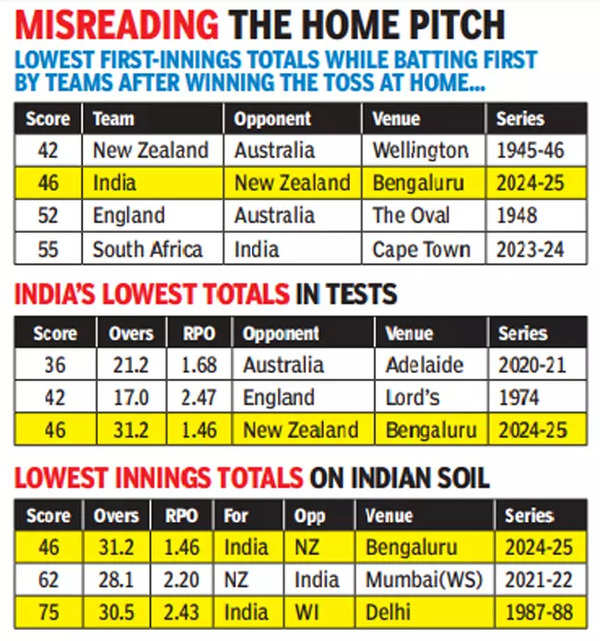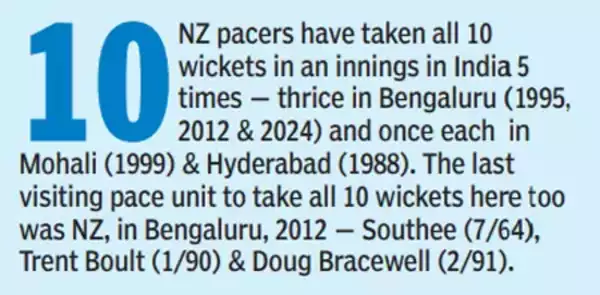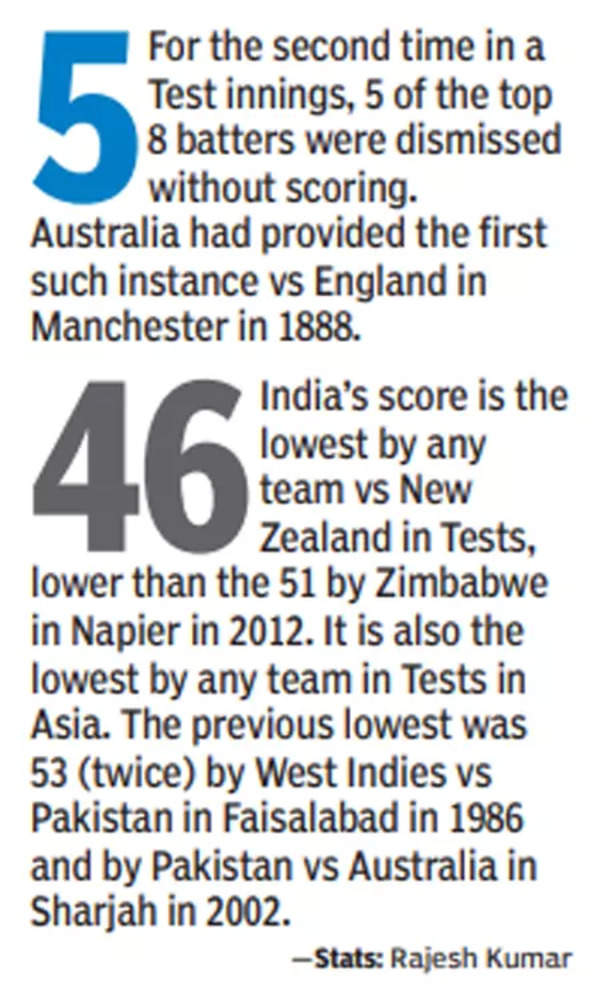[ad_1]

BENGALURU: One of the most indelible images of the day — on a day full of them — was slip fielder KL Rahul ducking from a Tom Latham edge that whizzed past him at comfortable catching height. This was just after New Zealand had overhauled India’s first-innings score. Rahul’s reaction was that he just didn’t see it, read it, or even anticipate it. It summed up India’s dismal performance on the second day of the first Test against New Zealand.
Consider this statistic: India were 46 all out in 31.2 overs in 163 minutes, New Zealand were 48 for no loss in 12.2 overs in 57 minutes. It was a narrative of contrasts on Thursday.
New Zealand’s quicks, led by Matt Henry (5/15) and assisted by Williams O’Rourke (4/22), stunned the Indian batters and forced the crowd at the M Chinnaswamy Stadium into such silence that a casual observer would have believed a funeral was in progress.
India batters embarrass in Bengaluru | What’s happening at Delhi Capitals? | Beyond the Boundary
India, who enjoyed unparalleled success on home turf for over a decade, have mastered the art of dismantling records in the intervening period. On the day, Rohit Sharma and his men knocked off quite a few, but of the infamous kind.
The total was India’s third lowest in a Test innings and the lowest at home. It was also the fourth-lowest first-innings score after electing to bat first. The five ducks in the innings are the joint second-highest and the second instance after the 1999 Mohali Test (also against NZ).
At stumps, the visitors, riding on Devon Conway’s 105-ball 91 (11×4; 3×6), were 180/3 in 50 overs with a 134-run lead.

Rain had washed out the opening day’s play on Wednesday and when play began on Thursday, the conditions were still overcast and the floodlights switched on. It seemed odd that India decided to go in with three spinners and to bat first.
There is time enough in this Test for Rohit and the team thinktank to justify those decisions, but at the end of the first day, they appeared controversial calls.
Bengaluru has a history of being unkind to teams that bat first on strips kept under wraps for the previous 24 hours or more. Batting in overcast conditions was never going to be easy but the Indians probably underestimated how difficult it could be.

The pacers generated ample swing, the ball moved viciously, the bounce was generous, and the carry was well-suited for seamers which included the experienced Tim Southee. The Indians may have acquitted themselves had they applied themselves better and seen off the first hour instead of trying to counter-attack.
New Zealand, in contrast, adapted quickly. They had two slips in place when play began and quickly beefed up the cordon once they realised just how helpful the conditions were to seamers.
Still, half the Indians who beat a hasty retreat to the dressing room either gifted or threw their wickets away. That said, full credit to the Black Caps. The pace trio hit an unwavering line and length and the fielders were on the money, plucking the ball from the air and getting their hands on every half chance barring one, which made no difference.

It took New Zealand eight deliveries before they began to pick India apart. Rohit led the batters parade. After surviving a close LBW decision on umpire’s call, he looked to break the shackles by stepping out against a Southee delivery. It jagged back and crashed into the stumps.
In the absence of Shubman Gill, down with a stiff neck, Virat Kohli returned to the No. 3 slot after a long hiatus. Sarfaraz Khan took Gill’s place in the line-up. Even before he could get an eye in, O’Rourke, towering at six feet six inches, surprised Kohli with the extra bounce which took off the glove and Glenn Phillips dived low to snatch it at leg slip.
What followed was carnage. Sarfaraz needlessly took the aerial route while Jaiswal, KL Rahul and Ravindra Jadeja found their plans going completely astray.
[ad_2]
Source link







